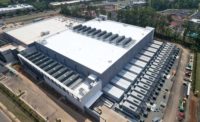It took a modern Trench cutting methods and Remixing Deep (TRD) machine to help excavate three 18th-century sailing ships at the Robinson Landing site on the Alexandria, Va. waterfront.
Working in historic districts such as Old Town Alexandria, “you never know what you will find,” says Greg Griffin, senior director at EYA Multifamily Construction LLC. A ship had been discovered in 2015 at an adjoining property and “everybody knew this was one of the oldest and most important sites, but we didn’t realize how intact the features were,” Griffin says.
As the layers of colonial Alexandria history dating back to 1749 were uncovered, the effort turned out to be three times the original expected cost of the archeological excavation, he says. Although significant, “it only represented a portion of the overall development costs for the approximately $185 million mixed-use project, which covers a full city block and includes 70 condos, 26 townhouses, retail and a restaurant with indoor/outdoor seating on the Potomac River waterfront. A renovated pier will include floating docks, areas for public seating and an outdoor lounge.
Bethesda, Md.-based lead developer EYA acquired the site along with development affiliates RTS SouthAssociates LLC, RTS Condo Associates LLC and RTS HomesAssociated LLC in the summer of 2016. Collectively known as Robinson Landing Development Entities, the group contracted with WSSI Thunderbird Archeology, a division and Wetland Studies and Solutions Inc. to conduct archeological exploration.
After the scope of the archeological excavation was expanded, the project’s budget was adjusted and a portion of project contingency was utilized to address the impact. Total archeology investigation and remediation effort exceeded 23 months.
Robison Landing opened for home sales in late 2017 and the full project is expected to be finished in the spring of 2020.
In addition to the timber frames of three ships, which were likely scuttled to help stabilize soil brought in to expand the shoreline, about 170 large “features” were uncovered, Griffin says. That includes foundations of several industrial buildings, including a 1783 warehouse and the 1854 Pioneer Mills, a large flour mill. Plus, more than 100,000 small artifacts such as pins, coins, seeds, pieces of pottery and petrified hardtack bread have been found.
“It literally looked like the archeologists were doing work in some historically rich place like Egypt or Italy,” he says. “There were stone floors, pieces of roads and the ships on the bottom, like they were just put there. It was like something out of Indiana Jones.”
The overall site was large enough that construction could move forward in areas that weren’t affected by the archeological finds, according to Griffin. He says they kept construction moving by beginning investigation while awaiting regulatory approvals, and by overlapping the start of major construction activities in and around archeological features while, at the same time, protecting the historic finds.
In the spring of 2017 two sets of what were initially thought to be historic human remains were found at the Robinson Landing site.
“Whenever there’s potential for human remains there is a clear protocol. As soon as the discovery was made, we protected the area, we followed regulations,” according to Griffin. “We were able to re-sequence work around that and leave that area protected while they established that there were no human remains.”
Digging Deep
While the archeologists knew about the foundations of the buildings beforehand, “at the bottom of the foundations we discovered there were ships,” says Neal Frumkin, project executive for general contractor Donohoe Construction, which is also based in Bethesda, Md.
Thunderbird Archeology had mapped out the location of the ship, according to Frumkin, and “they had a rough idea how deep it was but you never know when you start digging, you never know where the bottom is. You never know what’s beneath.”
The third largest ship was discovered on the property line property with a city street, so deep it was undermining one of the city walls, according to Frumkin. With the high-water table next to the river a critical challenge was keeping the site dry.
The solution was to bring in Hayward Baker Inc. with a Trench cutting and Remixing Deep (TRD) machine that Frumkin describes as “like a giant chain saw.”
Hayward Baker installed a cut-off wall of soil and cement mix to form a vertical barrier. Extending approximately 65-ft underground, the wall is embedded into marine clay to not only prevent water from getting into the site, but also to minimize the potential destabilizing of surrounding historic buildings, says Neil Stablow, senior vice president at Donohoe. Stablow also says “there will be minimal recharge of water thereby eliminating the need to design for uplift pressure.”
Joe Mann, senior project manager for Hayward Baker, says his team was “in the throes of the mobilization of our equipment when we realized that the excavation had to go deeper.”
The cut-off wall was always meant to be permanent structure, but a temporary component was added, according to Mann. “We had to do a number of changes on the fly to accommodate deeper excavation.”
At that stage the schedule was paramount, he says. “We were able do everything so that it did not add any time to the schedule. We had a swift review and approval” of the new steps that needed to be taken.
The third ship was removed in November. During the project, Frumkin says 20,000 tons of material was barged out on the Potomac River rather than trucked out on Alexandria streets.
The ships and other artifacts excavated from the site will be donated to the City of Alexandria for study and eventual exhibition.
Griffin calls it challenging, but exciting, to work on such an archeologically rich site. “There are headaches, but when you’re finished you can be proud not only that you built the project but that you preserved history that would never have been discovered.”
He says what makes it work “is your ability to react and put together the right team that allows you to deal with complex problems with creative solutions.”







Post a comment to this article
Report Abusive Comment